JWST - Operations - JWST NIRSpec
NIRSpec's Science OperationsNIRSpec is capable of obtaining near-infrared spectra of a rich diversity of astronomical objects. While optimized for observations of objects that are distant, faint, compact, and numerous (focusing on the "first light" and "assembly of galaxies" science themes), NIRSpec also offers observing modes suitable for studies of sources that are nearby, bright, and perhaps extended. The table below summarizes the various observing modes of NIRSpec and their main scientific applications. Multi-object spectroscopy will make use of the Micro-Shutter Assembly (MSA), while single-object spectroscopy will be performed using either the IFU (for extended objects) or the fixed slit aperture that best matches the object size and desired spectral resolution. To avoid the confusion that would be caused by overlapping grating orders, the full spectral range of NIRSpec is divided into three separate wavelength intervals, each requiring a separate exposure with a different order-sorting long-pass filter.
Every instrument mode listed in the table is allowed by instrument flight software and can be used safely. However, it is possible that some modes will not be fully calibrated or fully supported operationally.
|
| Mode | Target type | Wavelength range | Aperture mask | Spectral resolution |
|---|---|---|---|---|
| MSA spectroscopy | rich fields or very extended objects | 0.6 - 5.3 μm | any configuration of 0.2" x 0.46" micro-shutters | R~100 or R~1000 or R~2700 |
| Fixed slit spectroscopy | single compact object | 0.6 - 5.3 μm | 1.6" x 1.6" 0.2" x 3.3" 0.4" x 3.8" |
R~100 or R~1000 or R~2700 |
| Integral-field spectroscopy | moderately extended object | 0.6 - 5.3 μm | 3.0" x 3.0" IFU | R~100 or R~1000 or R~2700 |
| Target acquisition | reference stars (n ~ 10 - 20) | 0.8 - 2.0 μm | MSA shutters open, except around bright targets | undispersed imaging (MIRROR) |
| Internal calibrations | none | 0.6 - 5.3 μm | any configuration of micro-shutters and fixed slits / IFU | undispersed imaging or R~100 or R~1000 or R~2700 |
|
In order to assess the multiplexing capabilities of NIRSpec, it is useful to illustrate the location of spectra on the FPA. The figures below show where the spectra of the fixed slits and the virtual slit of the IFU fall on the FPA for the different dispersive elements. Although based on detailed optical simulations, these figures are indicative only, because small differences will be introduced by alignment tolerances and the actual performance of the dispersive elements. For the medium and high resolution modes, there are also slight differences in length and position for the three bands. A complete overview of NIRSpec's observing modes and its operation can be found in the Operations Concept Document (OCD) . |
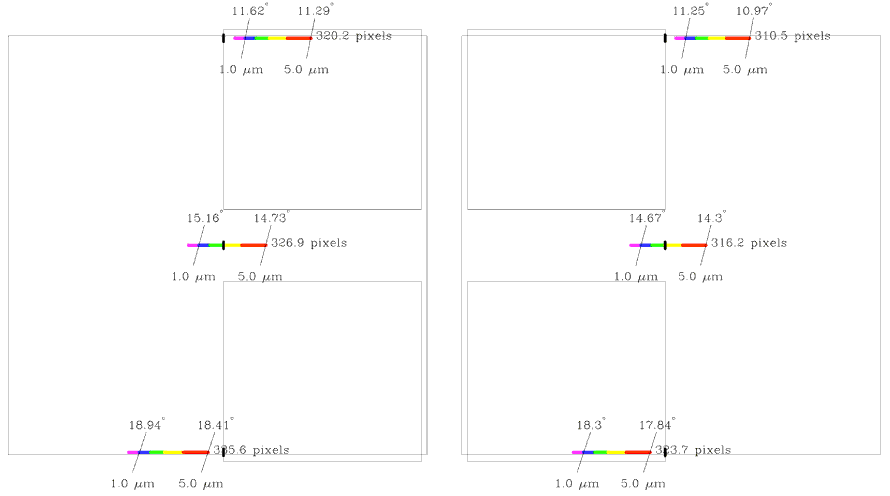 |
|
Location of the NIRSpec spectra obtained using the R~100 CaF2 prism. As in the following pictures, the four small rectangles depict the location and extent of the MSA quadrants, the two large squares outline the detector edges. The four spectra at the corners originate from micro-shutters in the extreme corners of the MSA.
|
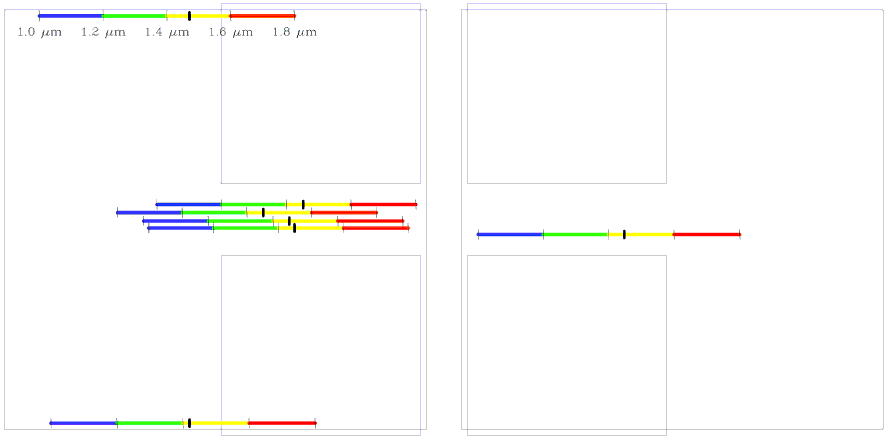 |
|
Location of the Band I (1.0 μm to 1.8 ) medium resolution (R~1000) spectra for the five fixed slits (middle) and the upper- and lower-most IFU virtual slits. The corresponding figure for Bands II and III appears almost identical. Note that because NIRSpec uses long-pass filters, the red end of the spectra is not an actual cut-off, the intrinsic source spectrum (plus overlapping higher orders of the in-band light) will extend up to the detector cut-off wavelength around 5 micron.
|
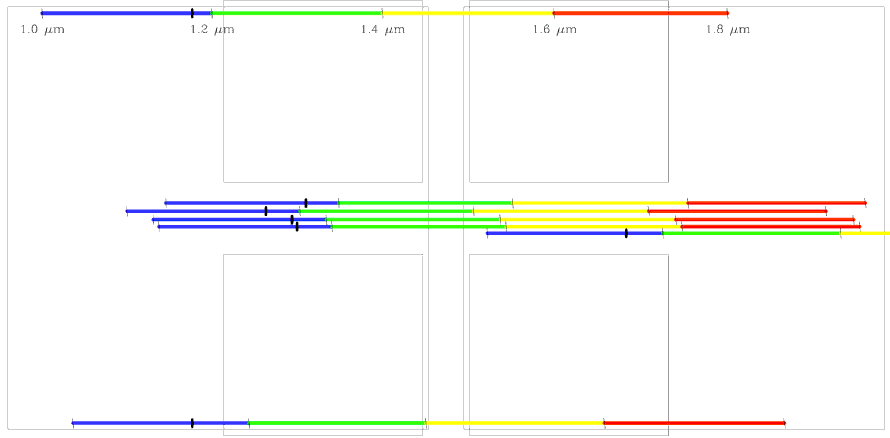 |
|
Location of the Band I high resolution (R~2700) mode. Again, Bands II and III show very similar spectra.
|
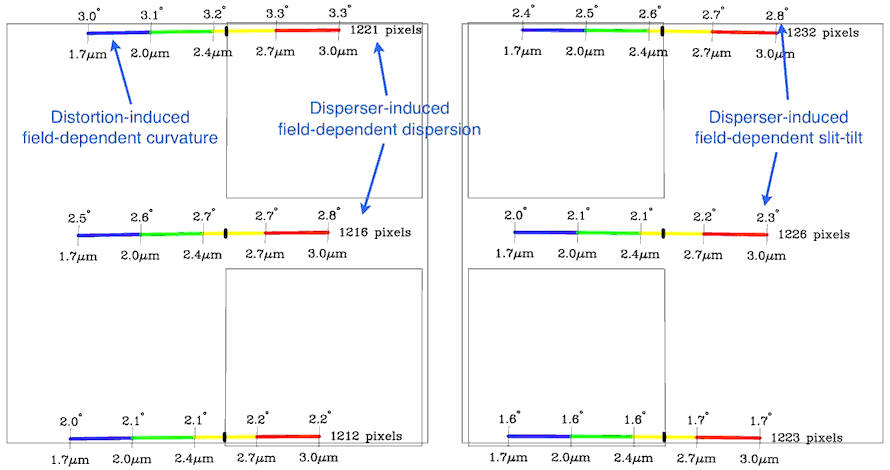 |
|
Variation of spectral curvature, dispersion, and slit tilt across the NIRSpec field-of-view in R~1000 Band II mode. Numbers are indicative only, and will be revised following flight model calibration.
|
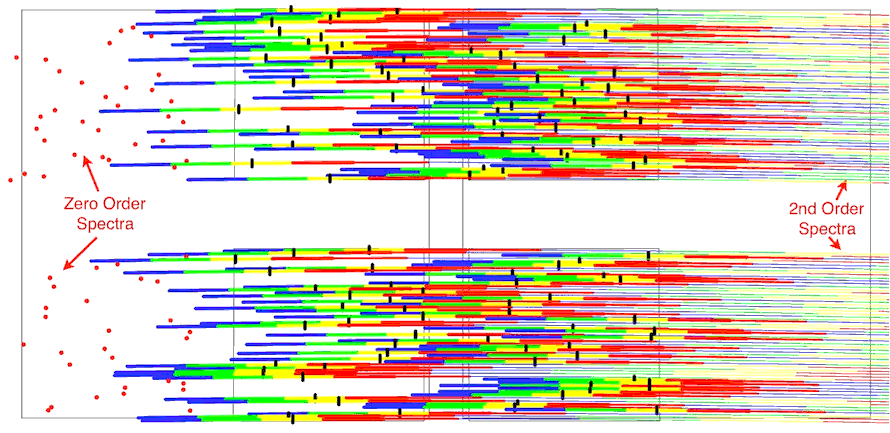 |
|
This figure shows the R~1000 spectra with an arbitrary configuration of open MSA shutters. In the R~1000 and R~2700 modes, the NIRSpec science spectra are produced in the first order of the gratings. For some of these spectra, orders other than the nominal fall onto the detector, as illustrated in the figure above. The second order simply overlaps with the red extension of the science spectrum (which is always present because of the long-pass filters). However, because of its brightness, the undispersed, "white light", zeroth order can potentially compromise the quality of some science data, as seen on the left-hand side of the figure. |
- Removed a total of (9) align=center.
- Removed a total of (3) border attribute.








































 Sign in
Sign in
 Science & Technology
Science & Technology